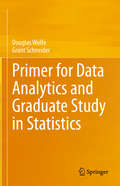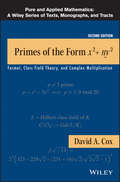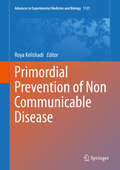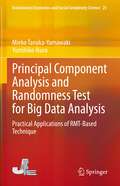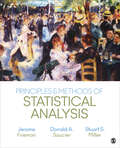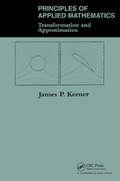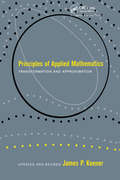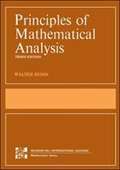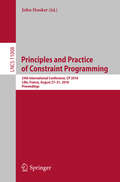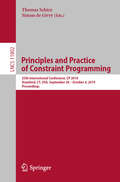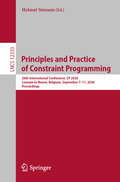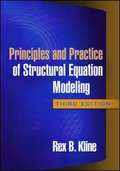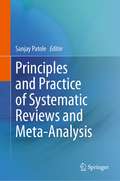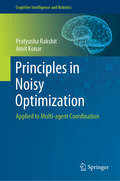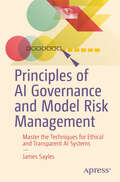- Table View
- List View
Primer for Data Analytics and Graduate Study in Statistics
by Grant Schneider Douglas WolfeThis book is specially designed to refresh and elevate the level of understanding of the foundational background in probability and distributional theory required to be successful in a graduate-level statistics program. Advanced undergraduate students and introductory graduate students from a variety of quantitative backgrounds will benefit from the transitional bridge that this volume offers, from a more generalized study of undergraduate mathematics and statistics to the career-focused, applied education at the graduate level. In particular, it focuses on growing fields that will be of potential interest to future M.S. and Ph.D. students, as well as advanced undergraduates heading directly into the workplace: data analytics, statistics and biostatistics, and related areas.
Primes and Particles: Mathematics, Mathematical Physics, Physics
by Martin H. KriegerMany philosophers, physicists, and mathematicians have wondered about the remarkable relationship between mathematics with its abstract, pure, independent structures on one side, and the wilderness of natural phenomena on the other. Famously, Wigner found the "effectiveness" of mathematics in defining and supporting physical theories to be unreasonable, for how incredibly well it worked. Why, in fact, should these mathematical structures be so well-fitting, and even heuristic in the scientific exploration and discovery of nature? This book argues that the effectiveness of mathematics in physics is reasonable. The author builds on useful analogies of prime numbers and elementary particles, elementary structure kinship and the structure of systems of particles, spectra and symmetries, and for example, mathematical limits and physical situations. The two-dimensional Ising model of a permanent magnet and the proofs of the stability of everyday matter exemplify such effectiveness, and the power of rigorous mathematical physics. Newton is our original model, with Galileo earlier suggesting that mathematics is the language of Nature.
Primes of the Form x2 + ny2
by David A. CoxAn exciting approach to the history and mathematics of number theory. " . . the authors style is totally lucid and very easy to read . . . the result is indeed a wonderful story. " "--Mathematical Reviews"Written in a unique and accessible style for readers of varied mathematical backgrounds, the "Second Edition "of "Primes of the Form p = x"2"""+ ny""2 "details the history behind how Pierre de Fermats work ultimately gave birth to quadratic reciprocity and the genus theory of quadratic forms. The book also illustrates how results of Euler and Gauss can be fully understood only in the context of class field theory, and in addition, explores a selection of the magnificent formulas of complex multiplication. "Primes of the Form p = x""2 ""+ ny""2"," Second Edition "focuses on addressing the question of when a prime "p "is of the form "x""2 ""+ ny""2"," "which serves as the basis for further discussion of various mathematical topics. This updated edition has several new notable features, including: - A well-motivated introduction to the classical formulation of class field theory- Illustrations of explicit numerical examples to demonstrate the power of basic theorems in various situations- An elementary treatment of quadratic forms and genus theory- Simultaneous treatment of elementary and advanced aspects of number theory- New coverage of the Shimura reciprocity law and a selection of recent work in an updated bibliography"Primes of the Form p = x""2 ""+ ny""2"," Second Edition "is both a useful reference for number theory theorists and an excellent text for undergraduate and graduate-level courses in number and Galois theory.
Primordial Prevention of Non Communicable Disease (Advances in Experimental Medicine and Biology #1121)
by Roya KelishadiThis volume provides a comprehensive overview on developmental origins of health and disease regarding various factors related to the origins of non-communicable diseases (NCDs) from early life. It offers a summary of the impacts of various factors such as epigenetics; gene-environment interaction; ethnic predisposition to NCDs and their risk factors; prenatal factors; fetal programming; maternal weight status and weight gain during pregnancy; type of feeding during infancy; growth pattern during childhood; obesity; stunting; socioeconomic status; dietary and physical activity habits; as well as environmental factors including air pollution and global climate change on the development and progress of NCDs.
Principal Bundles
by Stephen Bruce SontzThis introductory graduate level text provides a relatively quick path to a special topic in classical differential geometry: principal bundles. While the topic of principal bundles in differential geometry has become classic, even standard, material in the modern graduate mathematics curriculum, the unique approach taken in this text presents the material in a way that is intuitive for both students of mathematics and of physics. The goal of this book is to present important, modern geometric ideas in a form readily accessible to students and researchers in both the physics and mathematics communities, providing each with an understanding and appreciation of the language and ideas of the other.
Principal Bundles: The Classical Case (Universitext)
by Stephen Bruce SontzThis introductory graduate level text provides a relatively quick path to a special topic in classical differential geometry: principal bundles. While the topic of principal bundles in differential geometry has become classic, even standard, material in the modern graduate mathematics curriculum, the unique approach taken in this text presents the material in a way that is intuitive for both students of mathematics and of physics. The goal of this book is to present important, modern geometric ideas in a form readily accessible to students and researchers in both the physics and mathematics communities, providing each with an understanding and appreciation of the language and ideas of the other.
Principal Component Analysis and Randomness Test for Big Data Analysis: Practical Applications of RMT-Based Technique (Evolutionary Economics and Social Complexity Science #25)
by Mieko Tanaka-Yamawaki Yumihiko IkuraThis book presents the novel approach of analyzing large-sized rectangular-shaped numerical data (so-called big data). The essence of this approach is to grasp the "meaning" of the data instantly, without getting into the details of individual data. Unlike conventional approaches of principal component analysis, randomness tests, and visualization methods, the authors' approach has the benefits of universality and simplicity of data analysis, regardless of data types, structures, or specific field of science. First, mathematical preparation is described. The RMT-PCA and the RMT-test utilize the cross-correlation matrix of time series, C = XXT, where X represents a rectangular matrix of N rows and L columns and XT represents the transverse matrix of X. Because C is symmetric, namely, C = CT, it can be converted to a diagonal matrix of eigenvalues by a similarity transformation SCS-1 = SCST using an orthogonal matrix S. When N is significantly large, the histogram of the eigenvalue distribution can be compared to the theoretical formula derived in the context of the random matrix theory (RMT, in abbreviation). Then the RMT-PCA applied to high-frequency stock prices in Japanese and American markets is dealt with. This approach proves its effectiveness in extracting "trendy" business sectors of the financial market over the prescribed time scale. In this case, X consists of N stock- prices of length L, and the correlation matrix C is an N by N square matrix, whose element at the i-th row and j-th column is the inner product of the price time series of the length L of the i-th stock and the j-th stock of the equal length L. Next, the RMT-test is applied to measure randomness of various random number generators, including algorithmically generated random numbers and physically generated random numbers. The book concludes by demonstrating two applications of the RMT-test: (1) a comparison of hash functions, and (2) stock prediction by means of randomness, including a new index of off-randomness related to market decline.
Principal Symbol Calculus on Contact Manifolds (Lecture Notes in Mathematics #2359)
by Fedor Sukochev Yuri Kordyukov Dmitriy ZaninThis book develops a C*-algebraic approach to the notion of principal symbol on Heisenberg groups and, using the fact that contact manifolds are locally modeled by Heisenberg groups, on compact contact manifolds. Applying abstract theorems due to Lord, Sukochev, Zanin and McDonald, a principal symbol on the Heisenberg group is introduced as a homomorphism of C*-algebras. This leads to a version of Connes’ trace theorem for Heisenberg groups, followed by a proof of the equivariant behavior of the principal symbol under Heisenberg diffeomorphisms. Using this equivariance and the authors’ globalization theorem, techniques are developed which enable further extensions to arbitrary stratified Lie groups and, as a consequence, the notion of a principal symbol on compact contact manifolds is described via a patching process. Finally, the Connes trace formula on compact contact sub-Riemannian manifolds is established and a spectrally correct version of the sub-Riemannian volume is defined (different from Popp's measure). The book is aimed at graduate students and researchers working in spectral theory, Heisenberg analysis, operator algebras and noncommutative geometry.
Principia Mathematica to *56
by Bertrand Russell Alfred North WhiteheadThe great three-volume Principia Mathematica is deservedly the most famous work ever written on the foundations of mathematics. Its aim is to deduce all the fundamental propositions of logic and mathematics from a small number of logical premisses and primitive ideas, and so to prove that mathematics is a development of logic. This abridged text of Volume I contains the material that is most relevant to an introductory study of logic and the philosophy of mathematics (more advanced students will wish to refer to the complete edition). It contains the whole of the preliminary sections (which present the authors' justification of the philosophical standpoint adopted at the outset of their work); the whole of Part 1 (in which the logical properties of propositions, propositional functions, classes and relations are established); section 6 of Part 2 (dealing with unit classes and couples); and Appendices A and B (which give further developments of the argument on the theory of deduction and truth functions).
Principles & Methods of Statistical Analysis
by Jerome Frieman Donald A. Saucier Mr Stuart S. MillerThis unique intermediate/advanced statistics text uses real research on antisocial behaviors, such as cyberbullying, stereotyping, prejudice, and discrimination, to help readers across the social and behavioral sciences understand the underlying theory behind statistical methods. By presenting examples and principles of statistics within the context of these timely issues, authors Jerome Frieman, Donald A. Saucier, and Stuart S. Miller show how the results of analyses can be used to answer research questions. New techniques for data analysis and a wide range of topics are covered, including how to deal with “messy data” and the importance of engaging in exploratory data analysis.
Principles & Methods of Statistical Analysis
by Jerome Frieman Donald A. Saucier Mr Stuart S. MillerThis unique intermediate/advanced statistics text uses real research on antisocial behaviors, such as cyberbullying, stereotyping, prejudice, and discrimination, to help readers across the social and behavioral sciences understand the underlying theory behind statistical methods. By presenting examples and principles of statistics within the context of these timely issues, authors Jerome Frieman, Donald A. Saucier, and Stuart S. Miller show how the results of analyses can be used to answer research questions. New techniques for data analysis and a wide range of topics are covered, including how to deal with “messy data” and the importance of engaging in exploratory data analysis.
Principles Of Applied Mathematics: Transformation And Approximation
by James P. KeenerThis book is written for beginning graduate students in applied mathematics, science, and engineering, and is appropriate as a one-year course in applied mathematical techniques (although I have never been able to cover all of this material in one year). We assume that the students have studied at an introductory undergraduate level material on linear algebra, ordinary and partial differential equations, and complex variables. The emphasis of the book is a working, systematic understanding of classical techniques in a modern context. Along the way, students are exposed to models from a variety of disciplines. It is hoped that this course will prepare students for further study of modern techniques and in-depth modeling in their own specific discipline.
Principles Of Applied Mathematics: Transformation and Approximation
by James P. KeenerPrinciples of Applied Mathematics provides a comprehensive look at how classical methods are used in many fields and contexts. Updated to reflect developments of the last twenty years, it shows how two areas of classical applied mathematics spectral theory of operators and asymptotic analysis are useful for solving a wide range of applied science problems. Topics such as asymptotic expansions, inverse scattering theory, and perturbation methods are combined in a unified way with classical theory of linear operators. Several new topics, including wavelength analysis, multigrid methods, and homogenization theory, are blended into this mix to amplify this theme.This book is ideal as a survey course for graduate students in applied mathematics and theoretically oriented engineering and science students. This most recent edition, for the first time, now includes extensive corrections collated and collected by the author.
Principles Of Mathematical Analysis (International Series In Pure And Applied Mathematics)
by Walter RudinThe third edition of this well known text continues to provide a solid foundation in mathematical analysis for undergraduate and first-year graduate students. The text begins with a discussion of the real number system as a complete ordered field. (Dedekind's construction is now treated in an appendix to Chapter I.) The topological background needed for the development of convergence, continuity, differentiation and integration is provided in Chapter 2. There is a new section on the gamma function, and many new and interesting exercises are included. This text is part of the Walter Rudin Student Series in Advanced Mathematics.
Principles and Practice of Clinical Trials
by Curtis L. Meinert Steven PiantadosiThis is a comprehensive major reference work for our SpringerReference program covering clinical trials. Although the core of the Work will focus on the design, analysis, and interpretation of scientific data from clinical trials, a broad spectrum of clinical trial application areas will be covered in detail. This is an important time to develop such a Work, as drug safety and efficacy emphasizes the Clinical Trials process. Because of an immense and growing international disease burden, pharmaceutical and biotechnology companies continue to develop new drugs. Clinical trials have also become extremely globalized in the past 15 years, with over 225,000 international trials ongoing at this point in time. Principles in Practice of Clinical Trials is truly an interdisciplinary that will be divided into the following areas: 1) Clinical Trials Basic Perspectives2) Regulation and Oversight3) Basic Trial Designs4) Advanced Trial Designs5) Analysis6) Trial Publication7) Topics Related Specific Populations and Legal Aspects of Clinical Trials The Work is designed to be comprised of 175 chapters and approximately 2500 pages. The Work will be oriented like many of our SpringerReference Handbooks, presenting detailed and comprehensive expository chapters on broad subjects. The Editors are major figures in the field of clinical trials, and both have written textbooks on the topic. There will also be a slate of 7-8 renowned associate editors that will edit individual sections of the Reference.
Principles and Practice of Constraint Programming: 24th International Conference, Cp 2018, Lille, France, August 27-31, 2018, Proceedings (Lecture Notes in Computer Science #11008)
by John HookerThis book constitutes the proceedings of the 24th International Conference on Principles and Practice of Constraint Programming, CP 2018, held in Lille, France, in August 2018.The 41 full and 9 short papers presented in this volume were carefully reviewed and selected from 114 submissions. They deal with all aspects of computing with constraints including theory, algorithms, environments, languages, models, systems, and applications such as decision making, resource allocation, scheduling, configuration, and planning. The papers were organized according to the following topics/tracks: main technical track; applications track; CP and data science; CP and music; CP and operations research; CP, optimization and power system management; multiagent and parallel CP; and testing and verification.
Principles and Practice of Constraint Programming: 25th International Conference, CP 2019, Stamford, CT, USA, September 30 – October 4, 2019, Proceedings (Lecture Notes in Computer Science #11802)
by Thomas Schiex Simon De GivryThis book constitutes the proceedings of the 25th International Conference on Principles and Practice of Constraint Programming, CP 2019, held in Stamford, CT, USA, France, in September/October 2019.The 44 full papers presented in this volume were carefully reviewed and selected from 118 submissions. They deal with all aspects of computing with constraints including theory, algorithms, environments, languages, models, systems, and applications such as decision making, resource allocation, scheduling, configuration, and planning. The papers were organized according to the following topics/tracks: technical track; application track; multi-agent and parallel CP track; testing and verification track; CP and data science track; computational sustainability; and CP and life sciences track.
Principles and Practice of Constraint Programming: 26th International Conference, CP 2020, Louvain-la-Neuve, Belgium, September 7–11, 2020, Proceedings (Lecture Notes in Computer Science #12333)
by Helmut SimonisThis book constitutes the proceedings of the 26th International Conference on Principles and Practice of Constraint Programming, CP 2020, held in Louvain-la-Neuve, Belgium, in September 2020. The conference was held virtually due to the COVID-19 pandemic. The 55 full papers presented in this volume were carefully reviewed and selected from 122 submissions. They deal with all aspects of computing with constraints including theory, algorithms, environments, languages, models, systems, and applications such as decision making, resource allocation, scheduling, configuration, and planning. The papers were organized according to the following topics/tracks: technical track; application track; and CP and data science and machine learning.
Principles and Practice of Structural Equation Modeling (3rd Edition)
by Rex B. KlineFor students and researchers in the social sciences who do not have an extensive quantitative background, Kline (psychology, Concordia U. , Montreal) explains the principles, assumptions, strengths, limitations and applications of structural equation modeling. His presentation therefore is conceptual rather than mathematically oriented, with few formulas and symbols and many examples in a number of disciplines. Among his topics are fundamental concepts, computer tools, identification, hypothesis testing, and mean structures and latent growth models. No dates are noted for previous editions. Annotation ©2010 Book News, Inc. , Portland, OR (booknews. com)
Principles and Practice of Systematic Reviews and Meta-Analysis
by Sanjay PatoleEvidence based medicine is at the core of modern medicine. It involves the integration of individual clinical expertise with the best available clinical evidence from systematic research and patient's values and expectations. Systematic reviews offer a summary of the best available evidence. They are the most reliable and comprehensive statement about what works. Written by clinical academics from Australia, UK, USA, and Switzerland, this contributed volume introduces the readers to the principles and practice of systematic reviews and meta-analysis. It covers the various steps involved in systematic reviews including development of a focused question and the strategy for conducting a comprehensive literature search, identifying studies addressing the underlying question, assessment of heterogeneity and the risk of bias in the included studies, data extraction, and the approach to meta-analysis. Crucial issues such as selecting the model for meta-analysis, generating and interpreting forest plots, assessing the risk of publication bias, cautions in the interpretation of subgroup and sensitivity analyses, rating certainty of the evidence using GRADE guideline, and standardized reporting of meta-analysis (PRISMA) are covered in detail. Every attempt is made to keep the narrative simple and clear. Mathematical formulae are avoided as much as possible. While the focus of this book is on systematic reviews and meta-analyses of randomised controlled trials (RCTs), the gold standard of clinical research, the essentials of systematic reviews of non-RCTs, diagnostic test accuracy studies, animal studies, individual participant data meta-analysis, and network meta-analysis are also covered. Readers from all faculties of medicine will enjoy this comprehensive and reader friendly book to understand the principles and practice of systematic reviews and meta-analysis for guiding their clinical practice and research.
Principles and Practices for a Federal Statistical Agency
by Social Sciences Education Division On BehavioralPublicly available statistics from government agencies that are credible, relevant, accurate, and timely are essential for policy makers, individuals, households, businesses, academic institutions, and other organizations to make informed decisions. Even more, the effective operation of a democratic system of government depends on the unhindered flow of statistical information to its citizens. In the United States, federal statistical agencies in cabinet departments and independent agencies are the governmental units whose principal function is to compile, analyze, and disseminate information for such statistical purposes as describing population characteristics and trends, planning and monitoring programs, and conducting research and evaluation. The work of these agencies is coordinated by the U. S. Office of Management and Budget. Statistical agencies may acquire information not only from surveys or censuses of people and organizations, but also from such sources as government administrative records, private-sector datasets, and Internet sources that are judged of suitable quality and relevance for statistical use. They may conduct analyses, but they do not advocate policies or take partisan positions. Statistical purposes for which they provide information relate to descriptions of groups and exclude any interest in or identification of an individual person, institution, or economic unit. Four principles are fundamental for a federal statistical agency: relevance to policy issues, credibility among data users, trust among data providers, and independence from political and other undue external influence. Principles and Practices for a Federal Statistical Agency: Fifth Edition explains these four principles in detail.
Principles in Noisy Optimization: Applied to Multi-agent Coordination (Cognitive Intelligence and Robotics)
by Amit Konar Pratyusha RakshitNoisy optimization is a topic of growing interest for researchers working on mainstream optimization problems. Although several techniques for dealing with stochastic noise in optimization problems are covered in journals and conference proceedings, today there are virtually no books that approach noisy optimization from a layman’s perspective; this book remedies that gap. Beginning with the foundations of evolutionary optimization, the book subsequently explores the principles of noisy optimization in single and multi-objective settings, and presents detailed illustrations of the principles developed for application in real-world multi-agent coordination problems. Special emphasis is given to the design of intelligent algorithms for noisy optimization in real-time applications. The book is unique in terms of its content, writing style and above all its simplicity, which will appeal to readers with a broad range of backgrounds.The book is divided into 7 chapters, the first of which provides an introduction to Swarm and Evolutionary Optimization algorithms. Chapter 2 includes a thorough review of agent architectures for multi-agent coordination. In turn, Chapter 3 provides an extensive review of noisy optimization, while Chapter 4 addresses issues of noise handling in the context of single-objective optimization problems. An illustrative case study on multi-robot path-planning in the presence of measurement noise is also highlighted in this chapter. Chapter 5 deals with noisy multi-objective optimization and includes a case study on noisy multi-robot box-pushing. In Chapter 6, the authors examine the scope of various algorithms in noisy optimization problems. Lastly, Chapter 7 summarizes the main results obtained in the previous chapters and elaborates on the book’s potential with regard to real-world noisy optimization problems.
Principles of AI Governance and Model Risk Management: Master the Techniques for Ethical and Transparent AI Systems
by James SaylesNavigate the complex landscape of Artificial Intelligence (AI) governance and model risk management using a holistic approach encompassing people, processes, and technology. This book provides practical guidance, oversight structure and centers of excellence, and actionable insights for organizations seeking to harness the power of AI responsibly, ethically, and transparently. By addressing the technical, ethical, and societal dimensions of AI governance, organizations will be empowered to build trustworthy AI systems that benefit both their bottom line and the broader community. Featuring successful mitigating controls based on proven use cases, the book underscores the importance of aligning AI strategy with AI governance, striking a balance between AI innovation, risk mitigation as well as broader business goals. You’ll receive pointers for designing a well-governed AI development lifecycle, emphasizing transparency, accountability, and continuous monitoring throughout the AI development lifecycle. This book highlights the importance of collaboration between stakeholders, i.e., boards of directors, CxOs, corporate counsel, compliance officers, audit executives, data scientists, developers, validators, etc. You’ll gain practical advice on addressing the challenges related to the ownership of AI-generated content and models, stressing the need for legal frameworks and international collaboration. You’ll also learn the importance of auditing AI systems, developing protocols for rapid response in case of AI-related crises, and building capacity for AI actors through education. Principles of AI Governance and Model Risk Management demonstrates its value-added uniqueness by detailing a strategy to ensure a cohesive approach to managing AI-related risks, global compliance, policy, privacy, and AI-human collaboration and oversight. What You Will Learn Different approaches to AI adoption, from building in-house AI capabilities to partnering with external providers Key factors to consider when choosing an AI solution and how to ensure its successful integration into existing workflows AI technologies, their business impact, and ethical considerations to make informed decisions and foster responsible AI The environmental impacts of AI systems and the need for sustainable practices in AI development and deployment. Who This Book is For Business executives and process owners/representatives, risk officers, cybersecurity professionals, legal counsel and ethics officers, human resource professionals, data scientists, AI developers, and CTOs.
Principles of Algebraic Geometry
by Joseph Harris Phillip GriffithsA comprehensive, self-contained treatment presenting general results of the theory. Establishes a geometric intuition and a working facility with specific geometric practices. Emphasizes applications through the study of interesting examples and the development of computational tools. Coverage ranges from analytic to geometric. Treats basic techniques and results of complex manifold theory, focusing on results applicable to projective varieties, and includes discussion of the theory of Riemann surfaces and algebraic curves, algebraic surfaces and the quadric line complex as well as special topics in complex manifolds.
Principles of Applied Statistics
by D. R. Cox Christl A. DonnellyApplied statistics is more than data analysis, but it is easy to lose sight of the big picture. David Cox and Christl Donnelly distil decades of scientific experience into usable principles for the successful application of statistics, showing how good statistical strategy shapes every stage of an investigation. As you advance from research or policy question, to study design, through modelling and interpretation, and finally to meaningful conclusions, this book will be a valuable guide. Over a hundred illustrations from a wide variety of real applications make the conceptual points concrete, illuminating your path and deepening your understanding. This book is essential reading for anyone who makes extensive use of statistical methods in their work.
